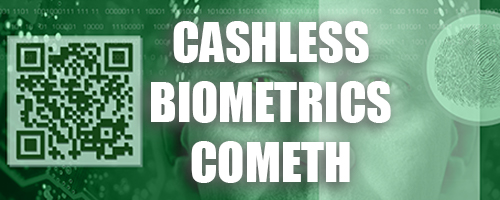Cashless Biometrics and India’s Demonetization Experiment
by James Corbett
TheInternationalForecaster.com
January 24, 2017
Well, that didn’t take long.
In the wake of India’s demonetization of the 500 and 1,000 rupee notes last November, I wrote an editorial (“Crisitunity in India’s Cash Crunch“) where I noted that one significant reason for the drastic move was the chance to rein in India’s sizable informal economy:
“In India, they call cash gleaned from counter-economic activities ‘black money.’ It’s not known to the government, it’s not stored in the banks, and it’s not taxed. In other words, it’s the would-be technocratic overlords’ worst nightmare. It’s impossible to know the size of this ‘black money’ pool (can we call it something cooler, like ‘freedom funds’ or something?) but it has been estimated to be as much as 20% the size of the total Indian economy. Now with the vast bulk of those freely-gotten gains being brought back into the banking system (or exchanged with a valid form of government identification), it will come back under the purview of Big Brother and his friend, Uncle Taxman.
As if on cue, earlier this month the Indian income tax department began asking banks for data on their customers’ bank deposits between April and November of last year so they could better analyze the cash that was being turned in for signs of “suspicious” activity. And now, the latest from the Hindustan Times:
“People who deposited huge amounts of cash in their bank accounts after the Centre’s demonetisation exercise may get multiple notices from the Income Tax department through the rest of the year.
“The department – which has started sending notices to those who deposited currency over Rs 2 lakh [200,000 rupees, or about US$3000] after November 9 – directed its officials to ensure that “genuine” cases are dissolved at the earliest. Probes would then be undertaken against those found to have “fuzzy” sources of income. The mammoth exercise could go on till the next financial year, sources said.”
The article goes on to note that “using risk-based data analytics of cash deposits in bank accounts to distinguish between genuine and not genuine cases, the tax department has become capable of targeting even entry-level operators.” Not only that, but we now learn that “the government has begun analysing deposits in new accounts and loan repayments as well as transfers to e-wallets and advance remittance for imports during the last 10 days of deadline to turn in junked notes.”
In other words, the poorest of the poor and the previously unbanked have now been duly identified and branded as tax cattle, ripe for the fleecing (to mix a metaphor). No surprise there.
Indeed, as Satya Sagar points out in our recent conversation on the demonetization scheme, if this scheme were really about cracking down on so-called “black money,” it’s a colossal misstep. Only 6% of the so-called “black money” is actually held in cash, as those looking to evade the taxman invest it in real estate, gold, or foreign bank accounts, and much of the “illicit” cash that is flowing around the system is used as slush funds, bribes and kickbacks to corrupt politicians.
Instead, this campaign can be seen as an attempt to accomplish, among other things, the identification and registration of the previously unbanked and untaxed masses, and the kick-starting of India’s nascent cashless-payment economy.
The first aim is particularly interesting in light of India’s ongoing efforts to force its 1.2 billion residents into the world’s largest biometric database. And the second aim is particularly interesting in light of Norbert Häring’s recent report on how a little-noticed USAID program seems to have been the “catalyst” for this demonetization experiment:
“Not even four weeks before this assault on Indians, USAID had announced the establishment of ‘Catalyst: Inclusive Cashless Payment Partnership,’ with the goal of effecting a quantum leap in cashless payment in India. The press statement of October 14 says that Catalyst ‘marks the next phase of partnership between USAID and Ministry of Finance to facilitate universal financial inclusion.’”
But the effort to biometrically register the population and the effort to transition into a cashless economy are, in fact, intimately related. As Häring notes, Alok Gupta, Catalyst‘s “Director of Project Incubation,” was an original member of the team that developed Aadhaar, the Indian government’s biometric identification system. And wouldn’t you know it, the latest word from the World Economic Forum at Davos is that India is going to skip right over card-based cashless payments and go straight to biometric e-payments. According to biometricupdate.com:
“The chief executive of India’s leading economic development agency told attendees at the World Economic Forum in Davos that the country could introduce biometric payments within three years, thereby eliminating the need for cash and typical electronic payment methods, including: automated teller machines, along with debit and credit cards.”
That’s right, Amitabh Kant, the head of the National Institution for Transforming India, a government-run policy institute, told the assembled globalists at Davos that India would leapfrog straight over the card-based economy and into the world of biometric payments. As he was creepily quoted by CNN: “Each one of us in India will be a walking ATM.”
This is the direction that things are going in India. And, as I will discuss later this week on The Corbett Report, what is unfolding right now in India is no more than a test run for what will soon be implemented around the world should the globalists get their way.
___
http://www.corbettreport.com/cashless-biometrics-and-indias-demonetization-experiment/
